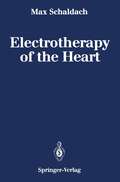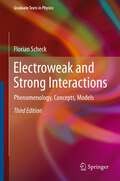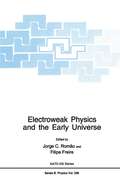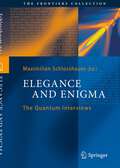- Table View
- List View
Electrostatic Precipitation: 11th International Conference on Electrostatic Precipitation, Hangzhou, 2008
by Keping Yan"Electrostatic Precipitation" includes selected papers presented at the 11th International Conference on Electrostatic Precipitation. It presents the newest developments in electrostatic precipitation, flue gas desulphurization (FGD), selective catalytic reduction (SCR), and non-thermal plasma techniques for multi-pollutants emission control. Almost all outstanding scientists and engineers world-wide in the field will report their on-going researches. The book will be a useful reference for scientists and engineers to keep abreast of the latest developments in environmental science and engineering.
Electrostatics (contracted)
by RnibThis diagram shows how negative electrons can move from one object to another. On the left hand side of the page is a rectangle labelled "glass rod" which contain positive and negative charges. On the bottom right of the rod is an open arrow with negative charges inside. The arrow points right to another shape which has few positive charges and many negative ones.
Electrostatics of Soft and Disordered Matter
by David S. Dean Jure Dobnikar Ali Naji Rudolf PodgornikRecently, there has been a surge of activity to elucidate the behavior of highly charged soft matter and Coulomb fluids in general. Such systems are ubiquitous, especially in biological matter where the length scale and the strength of the interaction between highly charged biomolecules are governed by strong electrostatic effects. Several interest
Electrotechnologies for Extraction from Food Plants and Biomaterials (Food Engineering Series)
by Nikolai Lebovka Eugène VorobievRecently, the electrotechnologies based on the effects of pulsed electric fields (PEF), such as ohmic heating (OH) and DC electric field, have gained real interest in the field of food processing. These techniques efficiently enhance methods of extraction from food plants and dehydration of biosolids. The PEF and pulsed OH techniques preserve the nutritional, functional, structural and sensory properties of products better than conventional extraction technologies. The electrofiltration and electro-osmotic dewatering can be very effective for the separation of bioproducts and dehydration of food wastes. The first source book in the field, this book gives an overview the fundamental principles of electrical techniques, electrophysical properties of foods and agricultural products, application of various emerging electrotechnologies for enhancing the solid-liquid separation and drying processes, extraction techniques of pigments, processing methods of different in-plant tissues and biosolids, electro-osmotic dewatering and electrofiltration of biomaterials, recent industrial- scale gains, and other aspects. Each chapter is complementary to other chapters and addresses the latest efforts in the field.
Electrotherapy of the Heart: Technical Aspects in Cardiac Pacing
by Max SchaldachSince 1958, when the first cardiac pacing system was implanted, the exemplary collaboration between medicine and engineering has developed into an extremely successful therapy. The book highlights many of the recent and most important technological advances and shows the multidisciplinary nature of the technical task of pacemaker development which is based on the diverse components of physiology, electronics, physics, electrochemistry and the material sciences.
Electrotransformation of Bacteria (Springer Lab Manuals)
by Natalie Eynard Justin TeissieIn this manual, protocols for the transformation of about 40 strains of bacteria are described, with the emphasis placed on the individual critical procedural steps, since the practical details mainly depend on the bacterial strain under investigation. This presentation together with the theoretical introductionary chapters, allows users to modify and adapt each protocol to their own experiments. Bacterial strains with relevance in the food industry, biotechnology, medical and veterinary fields, agroindustry and environmental sciences are covered.
Electroweak and Strong Interactions: Phenomenology, Concepts, Models (Graduate Texts in Physics)
by Florian ScheckAfter an introduction to relativistic quantum mechanics, which lays the foundation for the rest of the text, the author moves on to the phenomenology and physics of fundamental interactions via a detailed discussion of the empirical principles of unified theories of strong, electromagnetic, and weak interactions. There then follows a development of local gauge theories and the minimal standard model of the fundamental interactions together with their characteristic applications. The book concludes with further possibilities and the theory of interactions for elementary particles probing complex nuclei.Numerous exercises with solutions make this an ideal text for graduate courses on quantum mechanics and elementary particle physics.
Electroweak and Strong Interactions: An Introduction to Theoretical Particle Physics (Graduate Texts in Physics)
by Florian ScheckAfter an introduction to relativistic quantum mechanics, which lays the foundation for the rest of the text, the author moves on to the phenomenology and physics of fundamental interactions via a detailed discussion of the empirical principles of unified theories of strong, electromagnetic, and weak interactions. There then follows a development of local gauge theories and the minimal standard model of the fundamental interactions together with their characteristic applications. The book concludes with further possibilities and the theory of interactions for elementary particles probing complex nuclei.Numerous exercises with solutions make this an ideal text for graduate courses on quantum mechanics and elementary particle physics.
Electroweak Baryogenesis and Its Phenomenology (Springer Theses)
by Kaori FuyutoThis thesis focuses on one of the mechanisms for solving the baryon asymmetry of the Universe (BAU) which is a long-standing open question in both particle physics and cosmophysics. Electroweak baryogenesis (EWBG) is one attractive hypothetical scenario to solve this mystery because it can be verified by collider experiments. The author aims to clarify the possibility of EWBG, and to show its verifiability using the Higgs physics and electric dipole moments (EDMs) of an electron, neutron, and proton. The thesis begins with a review of the BAU and EWBG. Subsequently, the possibility of EWBG in one effective model is discussed, which can be applied to some motivated physics beyond the Standard Model. Numerical analyses of electroweak phase transition and sphaleron solution are presented, and the closed time path formalism is also explained to estimate the BAU. After essential calculations for investigation of the possibility of EWBG, the relationship between the BAU and EDMs is described. Through the discussion of the result, it is concluded that both EDMs and the Higgs physics verify the scenario completely. The whole discussion in this thesis causes us to accept the current situation that is ripe for verification of EWBG.
Electroweak Effects at High Energies (Physics of Solids and Liquids)
by Harvey B. NewmanThe first Europhysics Study Conference on Electroweak Effects at High Energies was held at the "Ettore Majorana" Centre for Scientific Culture in Erice, Sicily from February 1 -12, 1983. The conference was attended by 61 physicists from 11 countries. The conference was sponsored by the European Physical Society, the Italian Ministry of Public Education, the Italian Ministry of Technological Research, the Sicilian Regional Government and the California Institute of Technology. CONFERENCE FORMAT The Study Conference followed a new intensive format in which the state of our knowledge of the electroweak interaction, and the relation of the electroweak sector to Grand Unified and Superunified Theories was reviewed in some depth. During the two week conference, 54 experimental and theoretical talks were presented, and four evening discussion sessions were held. The Erice surroundings, the wide-ranging conference program, and the fact that nearly all of the participants were directly involved in recent major experimental or theoretical developments, led to animated and very friendly discussions. Participants had the rare opportunity to view most of the major trends in high energy physics in a short interval of time, and to discuss and contemplate the trends in the uniquely peaceful yet stimulating atmosphere which is an Erice tradition.
Electroweak Gauginos with Highly Boosted Hadronically Decaying Bosons at the LHC (Springer Theses)
by Yuta OkazakiSupersymmetry (SUSY) introduces superpartners of the Standard Model (SM) particles. If their masses are typically O(100 GeV) ∼ O(TeV), a lightest neutralino can be a candidate for the dark matter, and the problem is solved by canceling the correction of the Higgs boson mass. Further, SUSY can explain the experimental result of the muon magnetic moment (g-2). This book presents a search for electroweakinos—the superpartners of the SM electroweak bosons—such as charginos and neutralinos using data at the LHC collected by the ATLAS detector. Pair-produced electroweakinos decay into the light ones and SM bosons (W/Z/h), and with the large mass difference between the heavy and light electroweakinos, the SM bosons have high momenta. In a fully hadronic final state, quarks decayed from the bosons are collimated, and can consequently be reconstructed as a single large-radius jet.This search has three advantages. The first is a statistical benefit by large branching ratios of the SM bosons. The second is to use characteristic signatures—the mass and substructure—of jets to identify as the SM bosons. The last is a small dependency on the signal model by targeting all the SM bosons. Thanks to them, the sensitivity is significantly improved compared to the previous analyses. Exclusion limits at the 95% confidence level on the heavy electroweakino mass parameter are set as a function of the light electroweakino mass parameter. They are set on wino or higgsino production models with various assumptions, such as the branching ratio of their decaying and the type of lightest SUSY particle. These limits are the most stringent limits. Besides, this book provides the most stringent constraints on SUSY scenarios motivated by the dark matter, the muon g-2 anomaly, and the naturalness.
Electroweak-Interacting Spin-1 Dark Matter and Its Phenomenology (Springer Theses)
by Motoko FujiwaraThis book offers construction of a renormalizable effective theory of electroweak-interacting spin-1 dark matter (DM). The effective theory realizes minimal but essential features of DM predicted in extra-dimension models, and enables to systematically treat non-perturbative corrections such as the Sommerfeld effects. Deriving an annihilation cross section including the Sommerfeld effects based on the effective theory, the author discusses the future sensitivity of observations to gamma-ray from the Galactic Center. As a result, the author explains the monochromatic gamma-ray signatures originate from two photons (γγ) or photon and Z boson (γZ) produced in the process of DM annihilations, and concludes a possible scenario that unstable neutral spin-1 particles (Z’) appear and results in a spectral peak in addition to the one caused by γγ and γZ channels in gamma-ray observations. If those two spectral peaks are observed, the masses of spin-1 DM and Z’ would be reconstructed.
Electroweak Interactions
by Luciano MaianiGet First-Hand Insight from a Contributor to the Standard Model of Particle PhysicsWritten by an award-winning former director-general of CERN and one of the world's leading experts on particle physics, Electroweak Interactions explores the concepts that led to unification of the weak and electromagnetic interactions. It provides the fundamental el
Electroweak Physics and the Early Universe (Nato Science Series B: #338)
by Jorge C. Romão Filipe FreireProceedings of a NATO ARW held in Sintra, Portugal, March 23-25, 1994
Electroweak Physics at LEP and LHC (Springer Tracts in Modern Physics #235)
by Arno StraessnerDuring more than 10 years, from 1989 until 2000, the LEP accelerator and the four LEP experiments, ALEPH, DELPHI, L3 and OPAL, have taken data for a large amount of measurements at the frontier of particle physics. The main outcome is a thorough and successful test of the Standard Model of electroweak interactions. Mass and width of the Z and W bosons were measured precisely, as well as the Z and photon couplings to fermions and the couplings among gauge bosons. The rst part of this work will describe the most important physics results of the LEP experiments. Emphasis is put on the properties of the W boson, which was my main research eld at LEP. Especially the precise determination of its mass and its couplings to the other gauge bosons will be described. Details on physics effects like Colour Reconnection and Bose-Einstein Correlations in W-pair events shall be discussed as well. A conclusive summary of the current electroweak measurements, including low-energy results, as the pillars of possible future ndings will be given. The important contributions from Tevatron, like the measurement of the top quark and W mass, will round up the present day picture of electroweak particle physics.
Electroweak Physics at the Large Hadron Collider with the ATLAS Detector: Standard Model Measurement, Supersymmetry Searches, Excesses, and Upgrade Electronics (Springer Theses)
by Elodie ResseguieThis thesis discusses searches for electroweakly produced supersymmetric partners of the gauge and the Higgs bosons (gauginos and higgsinos) decaying to multiple leptons, using pp collisions at sqrt(s) = 13 TeV. The thesis presents an in-depth study of multiple searches, as well as the first 13 TeV cross section measurement for the dominant background in these searches, WZ production. Two searches were performed using 36.1/fb of data: the gaugino search, which makes use of a novel kinematic variable, and the higgsino search, which produced the first higgsino limits at the LHC. A search using 139/fb of data makes use of a new technique developed in this thesis to cross check an excess of data above the background expectation in a search using a Recursive Jigsaw Reconstruction technique. None of the searches showed a significant excess of data, and limits were expanded with respect to previous results.These searches will benefit from the addition of luminosity during HL-LHC; however, the current detector will not be able to withstand the increase in radiation. Electronics for the detector upgrade are tested and irradiated to ensure their performance.
Electroweak Physics at the LHC (Springer Tracts in Modern Physics #267)
by Matthias U. MozerThe book discusses the recent experimental results obtained at the LHC that involve electroweak bosons. The results are placed into an appropriate theoretical and historical context. The work pays special attention to the rising subject of hadronically decaying bosons with high boosts, documenting the state-of-the-art identification techniques and highlighting typical results. The text is not limited to electroweak physics in the strict sense, but also discusses the use of electroweak vector-bosons as tool in the study of other subjects in particle physics, such as determinations of the proton structure or the search for new exotic particles. The book is particularly well suited for graduate students, starting their thesis work on topics that involve electroweak bosons, as the book provides a comprehensive description of phenomena observable at current accelerators as well as a summary of the most relevant experimental techniques.
Electroweak Processes in External Active Media (Springer Tracts in Modern Physics #252)
by Alexander Kuznetsov Nickolay MikheevExpanding on the concept of the authors’ previous book “Electroweak Processes in External Electromagnetic Fields,” this new book systematically describes the investigation methods for the effects of external active media, both strong electromagnetic fields and hot dense plasma, in quantum processes. Solving the solar neutrino puzzle in a unique experiment conducted with the help of the heavy-water detector at the Sudbery Neutrino Observatory, along with another neutrino experiments, brings to the fore electroweak physics in an active external medium. It is effectively demonstrated that processes of neutrino interactions with active media of astrophysical objects may lead, under some physical conditions, to such interesting effects as neutrino-driven shockwave revival in a supernova explosion, a “cherry stone shooting” mechanism for pulsar natal kick, and a neutrino pulsar. It is also shown how poor estimates of particle dispersion in external active media sometimes lead to confusion. The book will appeal to graduate and post-graduate students of theoretical physics with a prior understanding of Quantum Field Theory (QFT) and the Standard Model of Electroweak Interactions, as well as to specialists in QFT who want to know more about the problems of quantum phenomena in hot dense plasma and external electromagnetic fields.
Electroweak Processes in External Electromagnetic Fields (Springer Tracts in Modern Physics #197)
by Alexander Kuznetsov Nickolay MikheevAn exploration of the intersection of particle physics, astrophysics, and cosmology known as astroparticle physics. Extreme electromagnetic conditions present in puslars and other stars allow for investigations of the role of quantum processes in the dynamics of astrophysical objects and in the early Universe. Based in part on the authors' own work, this book systematically describes several methods of calculation of the effects of strong electromagnetic fields in quantum processes using analytical solutions of the Dirac equation and Feynmann diagrams at both the loop and tree levels. The consideration is emphasized at the two limiting cases: the case of a very strong magnetic field, and the case of a crossed field. The presentation will appeal to graduate students of theoretical physics with prior understanding of Quantum Field Theory (QFT) and the Standard Model of Electroweak Interactions, as well as specialists in QFT wishing to know more about the problems of quantum phenomena in external electomagnetic fields.
Electroweak Symmetry Breaking: By Dynamically Generated Masses of Quarks and Leptons (Springer Theses)
by Mgr.Adam SmetanaWith this thesis the author contributes to the development of a non-mainstream but long-standing approach to electroweak symmetry breaking based on an analogy with superconductivity. Electroweak symmetry breaking is assumed to be caused by dynamically generated masses of typical fermions, i.e., of quarks and leptons, which in turn assumes a new dynamics between quarks and leptons. Primarily it is designed to generate fermion masses and electroweak symmetry breaking is an automatic consequence.After the summary of the topic, the first main part of the thesis addresses the question as to whether the masses of known quarks and leptons provide sufficiently strong sources of electroweak symmetry breaking. It is demonstrated that neutrino masses subject to the seesaw mechanism are indispensable ingredients. The other two parts of the thesis are dedicated to the presentation of two particular models: The first model is based on the new strong Yukawa dynamics and serves as a platform for studying the ability to reproduce fermion masses. The second, more realistic model introduces a flavor gauge dynamics and its phenomenological consequences are studied.Even though, in the past, this type of models has already been of some interest, following the discovery of the Standard-Model-like Higgs particle, it is regaining its relevance.
Electrowetting: Fundamental Principles and Practical Applications
by Frieder Mugele Jason HeikenfeldStarting from the basic principles of wetting, electrowetting and fluid dynamics all the way up to those engineering aspects relevant for the development of specific devices, this is a comprehensive introduction and overview of the theoretical and practical aspects. Written by two of the most knowledgeable experts in the field, the text covers both current as well as possible future applications, providing basic working principles of lab-on-a-chip devices and such optofluidic devices as adaptive lenses and optical switches. Furthermore, novel e-paper display technology, energy harvesting and supercapacitors as well as electrowetting in the nano-world are discussed. Finally, the book contains a series of exercises and questions for use in courses on microfluidics or electrowetting. With its all-encompassing scope, this book will equally serve the growing community of students and academic and industrial researchers as both an introduction and a standard reference.
Electrowetting: Fundamental Principles and Practical Applications
by Frieder Mugele Jason HeikenfeldStarting from the basic principles of wetting, electrowetting and fluid dynamics all the way up to those engineering aspects relevant for the development of specific devices, this is a comprehensive introduction and overview of the theoretical and practical aspects. Written by two of the most knowledgeable experts in the field, the text covers both current as well as possible future applications, providing basic working principles of lab-on-a-chip devices and such optofluidic devices as adaptive lenses and optical switches. Furthermore, novel e-paper display technology, energy harvesting and supercapacitors as well as electrowetting in the nano-world are discussed. Finally, the book contains a series of exercises and questions for use in courses on microfluidics or electrowetting. With its all-encompassing scope, this book will equally serve the growing community of students and academic and industrial researchers as both an introduction and a standard reference.
Elegance and Enigma: The Quantum Interviews (The Frontiers Collection)
by Maximilian SchlosshauerQuantum mechanics is one of mankind's most remarkable intellectual achievements. Stunningly successful and elegant, it challenges our deepest intuitions about the world. In this book, seventeen physicists and philosophers, all deeply concerned with understanding quantum mechanics, reply to Schlosshauer's penetrating questions about the central issues. They grant us an intimate look at their radically different ways of making sense of the theory's strangeness. What is quantum mechanics about? What is it telling us about nature? Can quantum information or new experiments help lift the fog? And where are we headed next? Everyone interested in the contemporary but often longstanding conundrums of quantum theory, whether lay reader or expert, will find much food for thought in these pages. A wealth of personal reflections and anecdotes guarantee an engaging read. Participants: Guido Bacciagaluppi, Caslav Brukner, Jeffrey Bub, Arthur Fine, Christopher Fuchs, GianCarlo Ghirardi, Shelly Goldstein, Daniel Greenberger, Lucien Hardy, Anthony Leggett, Tim Maudlin, David Mermin, Lee Smolin, Antony Valentini, David Wallace, Anton Zeilinger, and Wojciech Zurek.
The Elegant Universe: Superstrings Hidden Dimensions And The Quest For The Ultimate (Sparknotes Literature Guide Series)
by Brian GreeneTHE 25th ANNIVERSARY EDITION - INCLUDING A NEW PREFACE AND EPILOGUE FROM BRIAN GREENEThe iconic bestseller that introduced legions to modern physics and the quest for the ultimate understanding of the cosmos, featuring a new preface and epilogue. With a rare blend of scientific insight and writing as graceful as the theories it explains, The Elegant Universe remains the unrivalled account of the modern search for the deepest laws of nature. In this new 25th anniversary edition, renowned physicist Brian Greene updates his classic work with a new preface and epilogue summarising the significant theoretical and experimental developments over the past quarter-century. From established science, including relativity and quantum mechanics, to the cutting edge of thinking on black holes, string theory, and quantum gravity, The Elegant Universe makes some of the most sophisticated concepts ever contemplated thoroughly accessible and entertaining, bringing us closer than ever to comprehending how the universe works.INTERNATIONAL BESTSELLERPULITZER PRIZE FINALIST'Compulsively readable...Greene threatens to do for string theory what Stephen Hawking did for holes' New York Times























